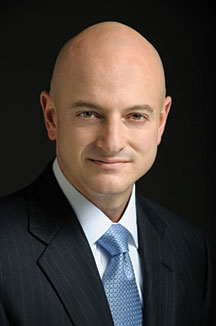INTERVIEW

I took sports psychology
and applied it to the
trading world to
improve performance.
Trading As A Sport?
Controlling Your Losses
With Dr. Doug
A former athlete and floor trader, Doug Hirschhorn, better known as trading psychologist and coach “Dr. Doug,” followed a circuitous path to the “Peak Performance” coaching for which he is best known. After playing Division I baseball in college, he spent a few years working on the trading floors in Chicago before deciding to earn the advanced degrees necessary to become a baseball coach. It was during graduate school he realized that if the psychological principles he was learning could be applied to athletes, why not try them out on traders — a similarly competitive breed? The idea worked. Less than five years later, Dr. Doug is an in-demand public speaker, counting Wall Streeters, hedge funds, and the largest banks in the world among his clients. Hirschhorn is currently the chief executive officer of DrDoug.com, a consulting firm. He is a regular contributor for Cnbc, where he currently hosts a weekly video blog. He may be reached at www.DrDoug.com.
Stocks & Commodities Editor Jayanthi Gopalakrishnan and Staff Writer Bruce Faber interviewed Dr. Doug via telephone on June 4, 2010.
Doug, how did you get started in your line of work?
After college I worked in the euro options pit. Then I traded at the Chicago Board of Trade (Cbot) in the fed funds pit and the bonds pit. Then, after about two and half years, I reinjured a herniated disk in my lower back that I originally hurt playing baseball my senior year in college and I had to quit the trading floor — I couldn’t stand for long periods. I went to electronic trading. I did that for six to eight months and decided that wasn’t what I wanted to do for a living. So I left trading altogether and went back to school to get the degrees to become a baseball coach. Then, as I was working with athletes and studying sports psychology, I realized that this was the same stuff I dealt with as a trader emotionally and psychologically, and I could apply the same strategies to help traders improve their performance. So I wrote my first book called The Trading Athlete, which was published by John Wiley. I took sports psychology and applied it to the trading world to improve performance.
I went on to do my doctoral work at West Virginia University, when I got a job offer at a trading firm in New York. I was there as their in-house trading performance coach for about two and a half years, and then I got a job offer to go work at a hedge fund, same role, before I eventually started my own consulting business.
We often hear that fear and greed drive the markets, but you say that fear and fear alone drives the markets. What do you mean?
Trading really is about fear. Traders are afraid of losing money and they are afraid of missing out on opportunities to make money. So when they are afraid of losing money, that is when the market starts going down. This is because they are all trying to undercut each other and limit their losses. And when they are afraid of missing out on the opportunity to make money is when the market goes up, because they are chasing the market on the upside.
Do you find that a lot of people tend to scale into positions when they do that?
Actually, what happens more often is people get into trades too quickly because they are so afraid of missing out on opportunities. As a result, they become impatient and they get in too big or too quick on trades when they should be scaling. Unfortunately, they don’t. They are afraid this is the best entry they’ll have, and as a result, they rush into the trade. And they end up stuck in the trade, and that is when they start to hope, wish, and pray that things turn around. That is when trades go very bad. I tell my clients about an expression: “H + W + P = E.” That is to remind them that any time they find themselves hoping, wishing, or praying, they need to exit the trade. I tell them to write “H + W + P = E” on a Post-it note and stick it on their monitors as a reminder.